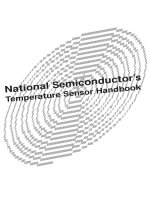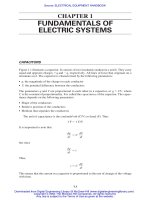EC&M’s Electrical Calculations Handbook potx
Bạn đang xem bản rút gọn của tài liệu. Xem và tải ngay bản đầy đủ của tài liệu tại đây (5.89 MB, 439 trang )
Simpo PDF Merge and Split Unregistered Version -
Electrical
Calculations
Handbook
EC&M’s
Simpo PDF Merge and Split Unregistered Version -
This page intentionally left blank.
Simpo PDF Merge and Split Unregistered Version -
EC&M’s
Electrical
Calculations
Handbook
John M. Paschal, Jr., P.E.
McGraw-Hill
New York San Francisco Washington, D.C. Auckland Bogotá
Caracas Lisbon London Madrid Mexico City Milan
Montreal New Delhi San Juan Singapore
Sydney Tokyo Toronto
Simpo PDF Merge and Split Unregistered Version -
Copyright © 2001 by The McGraw-Hill Companies, Inc. All rights reserved. Manufactured in the
United States of America. Except as permitted under the United States Copyright Act of 1976, no
part of this publication may be reproduced or distributed in any form or by any means, or stored
in a database or retrieval system, without the prior written permission of the publisher.
0-07-141480-0
The material in this eBook also appears in the print version of this title: 0-07-136095-6.
All trademarks are trademarks of their respective owners. Rather than put a trademark symbol
after every occurrence of a trademarked name, we use names in an editorial fashion only, and to
the benefit of the trademark owner, with no intention of infringement of the trademark. Where
such designations appear in this book, they have been printed with initial caps.
McGraw-Hill eBooks are available at special quantity discounts to use as premiums and sales
promotions, or for use in corporate training programs. For more information, please contact
George Hoare, Special Sales, at or (212) 904-4069.
TERMS OF USE
This is a copyrighted work and The McGraw-Hill Companies, Inc. (“McGraw-Hill”) and its
licensors reserve all rights in and to the work. Use of this work is subject to these terms. Except
as permitted under the Copyright Act of 1976 and the right to store and retrieve one copy of the
work, you may not decompile, disassemble, reverse engineer, reproduce, modify, create deriva-
tive works based upon, transmit, distribute, disseminate, sell, publish or sublicense the work or
any part of it without McGraw-Hill’s prior consent. You may use the work for your own non-
commercial and personal use; any other use of the work is strictly prohibited. Your right to use
the work may be terminated if you fail to comply with these terms.
THE WORK IS PROVIDED “AS IS”. McGRAW-HILL AND ITS LICENSORS MAKE NO
GUARANTEES OR WARRANTIES AS TO THE ACCURACY, ADEQUACY OR COM-
PLETENESS OF OR RESULTS TO BE OBTAINED FROM USING THE WORK, INCLUD-
ING ANY INFORMATION THAT CAN BE ACCESSED THROUGH THE WORK VIA
HYPERLINK OR OTHERWISE, AND EXPRESSLY DISCLAIM ANY WARRANTY,
EXPRESS OR IMPLIED, INCLUDING BUT NOT LIMITED TO IMPLIED WARRANTIES
OF MERCHANTABILITY OR FITNESS FOR A PARTICULAR PURPOSE. McGraw-Hill and
its licensors do not warrant or guarantee that the functions contained in the work will meet your
requirements or that its operation will be uninterrupted or error free. Neither McGraw-Hill nor
its licensors shall be liable to you or anyone else for any inaccuracy, error or omission, regard-
less of cause, in the work or for any damages resulting therefrom. McGraw-Hill has no respon-
sibility for the content of any information accessed through the work. Under no circumstances
shall McGraw-Hill and/or its licensors be liable for any indirect, incidental, special, punitive,
consequential or similar damages that result from the use of or inability to use the work, even if
any of them has been advised of the possibility of such damages. This limitation of liability shall
apply to any claim or cause whatsoever whether such claim or cause arises in contract, tort or
otherwise.
DOI: 10.1036/0071414800
Simpo PDF Merge and Split Unregistered Version -
Contents
Preface
xiii
Chapter 1. Basic Electrical Working Definitions and Concepts 1
Voltage as Potential Difference 1
Current 3
Resistance 4
Direct-Current (dc) Voltage Sources 4
Direct and Alternating Current 5
dc Voltage 6
Current Flow in a Resistive Circuit 15
Current Flow in a Series Resistive Circuit 16
Voltage Division in a Series Circuit 18
Power Rating of a Resistor 18
ac Voltage 23
ac Circuits with Resistance 23
ac Phase Angle and Power 26
Current and Power in a Single-Phase ac Circuit 33
Current and Power in a Three-Phase ac Circuit 33
Inductive Reactance 42
Capacitive Reactance 46
Impedance 52
Chapter 2. Three-Phase Systems 55
Wye-Connected Systems 58
Delta-Connected Systems 60
v
xi
For more information about this book, click here.
List of Problems
Copyright 2001 by The McGraw-Hill Companies, Inc. Click here for Terms of Use.
Simpo PDF Merge and Split Unregistered Version -
Chapter 3. Mathematics for Electrical Calculations,
Power Factor Correction, and Harmonics 69
Changing Vectors from Rectangular to Polar Form and
Back Again 69
Adding Vectors 70
Multiplying or Dividing Vectors 74
Solving for Current and Power Factor in an ac Circuit
Containing Only Inductive Reactance 75
Solving for Current and Power Factor in an ac Circuit
Containing Both Inductive Reactance and Resistance in
Series with One Another 77
Solving for Current and Power Factor in an ac Circuit
Containing Two Parallel Branches That Both Have Inductive
Reactance and Resistance in Series with One Another 77
Solving for Current and Power Factor in an ac Circuit
Containing Parallel Branches, One of Which Has Inductive
Reactance and Resistance in Series with One Another and
the Other of Which Has a Capacitive Reactance 79
Electrical Power in Common ac Circuits 79
Power Factor Correction to Normal Limits 87
Real Power (Kilowatts), Apparent Power (Kilovoltamperes),
Demand, and the Electrical Utility Bill 90
Power Factor Correction System Design in an Electrical Power
System Containing No Harmonics 93
Power Factor Correction System Design in an Electrical Power
System Containing Harmonics 104
Calculating the Parallel Harmonic Resonance of an Electrical
Power System Containing Capacitors 107
Resulting Values of Adding Harmonic Currents or Voltages 108
Acceptable Levels of Harmonic Current and Voltage 110
The Harmonic Current-Flow Model 111
Effects of Harmonic Current on Transformers 114
Effects of Harmonic Voltage on Motors 116
Harmonic Current Flow through Transformers 116
Harmonic Filters 117
Harmonics Symptoms, Causes, and Remedies 122
Chapter 4. Conductors 125
Conductors, Conductor Resistance, Conductor and Cable
Impedance, and Voltage Drop 125
Calculating the One-Way Resistance of a Wire 125
Calculating the Impedance of a Cable 133
Calculating Voltage Drop in a Cable 140
vi Contents
Simpo PDF Merge and Split Unregistered Version -
Calculating dc Resistance in a Bus Bar 143
Calculating Heat Loss in a Conductor 143
Wires and Cables 143
Determining Wire Size Given Insulation Type, Circuit Breaker
Clearing Time, and Short Circuit Current 160
Selecting the Proper Insulation for an Environment 161
Aluminum Conductors 170
Conductor and Cable Selection 170
Chapter 5. Short-Circuit Calculations 179
Sources of Short-Circuit Current 182
The Ability of the Electrical Utility System to Produce
Short-Circuit Current 183
Short-Circuit Contributions of On-Site Generators 184
Short-Circuit Contributions of Motors 185
Let-Through Values of Transformers 187
Let-Through Values of Reactors 188
Let-Through Power Values of Cables 189
Sample Short-Circuit Calculation 190
Chapter 6. Generator Sizing Calculations 195
Sizing a Gas-Turbine Generator Set for a Known Kilowatt Load 196
Sizing a Reciprocating Engine-Driven Generator Set for a
Known Kilowatt Load 198
Sizing of Generator Feeder Conductors 200
Chapter 7. Grounding 205
The Functions of Grounding 205
Calculating the Resistance to Remote Earth of Ground Rods 208
Grounding-Electrode Conductors 211
Equipment-Grounding Conductors 211
Methods of Grounding Systems 215
Obtaining the System Grounding Point 217
Chapter 8. Lighting 221
The Lumen Method 221
The Point-by-Point Method 223
Indoor Lighting 229
Lighting Rules of Thumb 245
Contents vii
Simpo PDF Merge and Split Unregistered Version -
Chapter 9. Transformers 251
Three-Phase Transformers 255
Overcurrent Protection of Transformers 265
Buck-Boost Autotransformers 275
Chapter 10. Motors 285
Selecting Motor Characteristics 286
Calculating Motor Running Current 295
Calculating Motor Branch-Circuit Overcurrent Protection
and Wire Size 296
Chapter 11. Raceways 311
Raceway Types and Their Characteristics 311
Chapter 12. Overcurrent Devices 319
Overcurrent Devices: Fuses and Circuit Breakers 319
Fuses 321
Circuit Breakers 323
Medium-Voltage and Special-Purpose Circuit Breakers
and Relay Controllers 325
Chapter 13. Circuits for Special Loads 335
Designing Circuits for Various Electrical Loads 335
Designing an Electrical System for a Commercial Building 339
Designing an Electrical System for an Industrial Facility 349
Chapter 14. Electrical Design and Layout Calculations 357
Straight-Through Pull Box in a Conduit System 357
Angle Pull Box in a Conduit System 358
Working Space Surrounding Electrical Equipment 358
Minimum Centerline-to-Centerline Dimensions of Knockouts
to Provide for Locknut Clearance 364
Chapter 15. Electrical Cost Estimating 371
Electrical Takeoff and Personnel-Hour Cost Estimating 371
Factoring of Labor Units 397
Estimate of Project Expense 409
viii Contents
Simpo PDF Merge and Split Unregistered Version -
Engineering Economics Calculations Considering the Time
Value of Money 411
Chapter 16. Conversion Calculations 425
Temperature Conversion Calculations 425
Frequently Used Conversion Calculations 425
Multiple Conversion Calculations 425
Index 433
Contents ix
Simpo PDF Merge and Split Unregistered Version -
This page intentionally left blank.
Simpo PDF Merge and Split Unregistered Version -
Preface
We all frequently need electrical reference material, and
sometimes we need an explanation of how certain electrical
equipment works, what dimensions are acceptable or unac-
ceptable, or approximately which values of things such as
voltage drop or wire size are reasonable. I have observed over
the years that there are certain electrical engineering and
design resources that I refer to more frequently than any oth-
ers. In my work I have also noticed that there are certain
types of calculations that are important enough to occur fre-
quently, but not frequently enough for me to have memorized
all of the dimensional or output data associated with them.
In addition, making calculations without reference values to
“go by” sets the stage for errors that could have been avoided
if similar calculations could be referred to. Finally, there is a
need for good explanatory material that can be shared with
fellow engineers or designers or with owners. Such informa-
tion is invaluable in helping them to make sound decisions,
since most thinking individuals can make a good decision
when given the correct data to consider.
It was with all of these in mind that I conceived of this
electrical calculations handbook. It is intended to be a
handy tool that provides in just one place much of the infor-
mation that one normally seeks from reference manuals; it
also provides solved “go-by” problems of the most-often-
encountered types in the electrical industry to expedite
solutions and make calculations easy. Instead of simply pro-
viding formulas without explanations, I took care to explain
each problem type and formula, and to prepare step-by-step
solutions. The problems covered in this book range from
xi
v
Copyright 2001 by The McGraw-Hill Companies, Inc. Click here for Terms of Use.
Simpo PDF Merge and Split Unregistered Version -
explanations of Ohm’s law and generator sizing, to lighting
calculations and electrical cost estimating and engineering
economics calculations. I made every effort to make the
book concise enough to be portable, while still including
the very best graphic illustrations. I also included, following
this preface, a detailed listing of problem types in alphabet-
ical order to make finding the proper “go-by” calculation
easy and fast.
I sincerely hope that you will find that keeping this “elec-
trical calculation reference library in one book” close by will
save you from having to carry several other reference
books, and that it will expedite your work while making it
easier and more accurate. I hope that the knowledge and
insight gained from it will add even more fun to your work
in our terrific electrical industry.
John M. Paschal, Jr., P.E.
xii Preface
Simpo PDF Merge and Split Unregistered Version -
List of Problems
Figure Solve for
1-27 ac current from voltage, power, and power factor
1-31 ac current given three-phase voltage, power, and power
factor
1-24 ac current in inductive circuit
1-24 ac current in resistive circuit
4-10 ac impedance of copper wire in conduit
4-10 ac resistance of aluminum wire in conduit
4-10 ac resistance of copper wire in conduit
1-32 ac voltage from three-phase current, resistance, and
power factor
1-28 ac voltage from current, resistance, and power factor
2-1 ac voltage given frequency of 60 Hz
2-2 ac voltage given frequency of 50 Hz
2-3 ac voltage selection given frequency and loads
4-6 Aluminum bus bar characteristics
4-1 Aluminum wire characteristics
4-31 Ambient temperature correction factor given ambient
temperature other than 30°C
1-29 Apparent power from voltage, current, and power factor
1-23 Apparent power in an ac circuit
1-18 Apparent power and true power of a resistor
1-19 Average voltage from peak voltage
4-2 AWG wire size from square-millimeter wire size
1-10 Battery output with temperature
xiii
v
Copyright 2001 by The McGraw-Hill Companies, Inc. Click here for Terms of Use.
Simpo PDF Merge and Split Unregistered Version -
Figure Solve for
1-4 Battery type
1-4 Battery voltage
4-30 Cable jacket materials for specific environments
4-39 Cable type from application criteria
3-17 Capacitor value given capacitor nameplate voltage
and connected voltage
3-14 Capacitor size required for power factor correction
to unity given initial power factor and load character-
istics
3-15 Capacitor size required for power factor correction to
any value given initial power factor and load charac-
teristics
15-23 Cash-flow diagram of a loan transaction at interest
15-24 Cash-flow diagram of a savings account at interest
8-4 Cavity reflectances from colors and surface criteria
8-5 Coefficient of utilization of a luminaire from fixture
type, room ratio, and surface reflectances
8-2 Common lamps and their characteristics
13-7 Conductor size for commercial lighting load
13-6 Conductor size for constant-wattage heat tracing cable
13-2 Conductor size for general continuous load
13-1 Conductor size for general load
13-8 Conductor size for general receptacle load
13-4 Conductor size for household appliance
13-3 Conductor size for HVAC load
13-5 Conductor size for self-regulated heat tracing cable
13-9 Conductor size for specific receptacle load
3-19 Conductor size to capacitor given capacitor size and
voltage
11-3 Conduit size given wire size, quantity, and insulation
type
16-1 Conversion formulas for temperature, °F and °C
16-2 Conversion formulas, units to units
16-3 Conversion methods using powers of 10
4-5 Copper bus bar characteristics
xiv List of Problems
Simpo PDF Merge and Split Unregistered Version -
Figure Solve for
4-1 Copper wire characteristics
4-33 Correction factor for more than three current-carrying
conductors in raceway
4-38 Cross-sectional areas of most commonly used wires
3-6 Current and power factor in a series circuit with
inductance and resistance
3-7 Current and power factor in parallel circuit with
inductance and resistance
3-8 Current and power factor in parallel circuit with
inductance, resistance, and capacitance
3-5 Current given inductance, power factor, and voltage
1-36 Current given inductive reactance and voltage
1-40 Current in an ac parallel circuit with inductance,
resistance, and capacitance
3-11 Current in feeder from group of motors given voltage
and motor characteristics
3-9 Current in motor and power factor given voltage and
motor characteristics
3-12 Current reduction from group of motors by power
factor correction capacitors at motor control center
3-13 Current reduction from group of motors by power
factor correction capacitors at motor control center
3-10 Current reduction from power factor correction capac-
itors placed at motor
1-38 Current through capacitor given capacitance and
voltage
1-39 Current through series inductance, capacitance, and
resistance
1-11 dc current in series circuit
1-12 dc voltage from voltage and resistance
10-7 Disconnecting means for motor given horsepower and
locked-rotor current
10-2 Efficiency changes from voltage variations above and
below nameplate voltage
7-4 Equipment grounding conductor parallel size given
overcurrent device rating
List of Problems xv
Simpo PDF Merge and Split Unregistered Version -
Figure Solve for
7-3 Equipment grounding conductor size given overcur-
rent device rating
1-15 Equivalent resistance from parallel resistances
1-14 Equivalent resistance from series resistances
1-16 Equivalent resistance from series-parallel resistance
network
2-4 Frequency given rpm and number of magnetic poles
15-21 Future value of a truck and trailer at the end of a
5-year life
6-2 Generator conductor overcurrent protection
6-1 Generator site rating from ISO rating, site tempera-
ture, and altitude
7-2 Grounding electrode conductor size given phase wire
size
7-10 Grounding methods, their characteristics, and their
results
3-21 Harmonic currents given nonlinear load character-
istics
3-29 Harmonic filter Q characteristics
3-30 Harmonic problem cause given problem characteristics
4-22 Heat losses of a copper bar from its dimensions and
ampere load
8-1 Horizontal footcandle value using point method
4-11 Impedance of 600-V, 5-kV, and 15-kV copper cable
1-37 Impedance of a coil from inductance and resistance
1-35 Inductive reactance from inductance and frequency
4-12 Inductive reactance of cable from conductor size and
dimensions
3-20 Inductor size between capacitor steps
4-29 Insulation system for environment given environment
characteristics
4-38 Insulation system of most commonly used wires
14-6 Knockout location dimensions from conduit sizes
15-7 Personnel hours for aluminum rigid conduit
installation
xvi List of Problems
Simpo PDF Merge and Split Unregistered Version -
Figure Solve for
15-14 Personnel hours for cable tray
15-9 Personnel hours for cables
15-13 Personnel hours for circuit breaker panelboards
15-2 Personnel hours for device installation
15-4 Personnel hours for EMT conduit and fittings
15-5 Personnel hours for heavy-wall steel conduit
15-6 Personnel hours for IMC conduit
15-1 Personnel hours for luminaire installation
15-15 Personnel hours for motor connections
15-16 Personnel hours for motor controllers
15-3 Personnel hours for outlet box installation
15-8 Personnel hours for PVC conduit installation
15-12 Personnel hours for safety switches
15-11 Personnel hours for transformers
15-10 Personnel hours for wire connectors
3-24 Maximum allowable current distortion values
10-12 Motor characteristics given chart of load data
10-10 Motor circuit wire ampacity for continuous duty
motor driving a periodic duty load
10-11 Motor circuit wire ampacity for continuous duty
motor driving a varying duty load
10-9 Motor circuit wire ampacity for continuous-duty
motor driving an intermittent duty load
10-8 Motor circuit wire ampacity for continuous-duty
motor with continuous load
10-3 Motor code letter from kilovoltampere/horsepower
ratio
9-5 Motor coil voltage from generator voltage
9-6 Motor coil voltage from generator voltage
10-6 Motor full-load current given motor horsepower
10-4 Motor inrush current from horsepower, code letter,
and voltage
10-1 Motor synchronous speed from frequency, poles, and
motor type
List of Problems xvii
Simpo PDF Merge and Split Unregistered Version -
Figure Solve for
10-2 Motor torque changes from voltage variations above
and below nameplate voltage
11-4 NEMA enclosure given the environment characteristics
7-5 Neutral grounded conductor minimum size given
phase conductor size
13-7 Overcurrent device rating for commercial lighting load
13-6 Overcurrent device rating for constant wattage heat
tracing cable
13-2 Overcurrent device rating for general continuous load
13-1 Overcurrent device rating for general load
13-8 Overcurrent device rating for general receptacle load
13-5 Overcurrent device rating for heat tracing cable
13-4 Overcurrent device rating for household appliance
13-3 Overcurrent device rating for HVAC load
10-5 Overcurrent device rating for motor branch circuit
given ampere load
13-9 Overcurrent device rating for specific receptacle load
9-11 Overcurrent protection rating of transformers greater
than 600 V
9-12 Overcurrent protection rating of transformers less
than 600 V
9-13 Overcurrent protection rating of transformers less
than 600 V
9-10 Overcurrent protection rating of transformers over
600 V
15-25 Payment amounts required to accumulate a given
sum at a future time with interest
1-21 Phase angle between voltage and current in a resis-
tive circuit
1-22 Phase angle between voltage and current in an induc-
tive circuit
10-2 Power factor changes from voltage variations above
and below nameplate voltage
1-34 Power factor from three-phase voltage, current, and
true power
xviii List of Problems
Simpo PDF Merge and Split Unregistered Version -
Figure Solve for
1-30 Power factor from voltage, current, and true power
15-22 Present value of maintenance cost
14-2 Pull-box dimensions for an angle pull
14-1 Pull-box dimensions for straight-through pull
8-6 Quantity of luminaires from luminaire characteristics
and room characteristics
11-2 Raceway cross-sectional areas given raceway type
3-28 Reactor value of harmonic filter given frequency and
capacitor size
12-4 Relay selection for large generator protection
12-6 Relay selection for large induction motor protection
12-5 Relay selection for large transformer protection
12-2 Relay selection for medium-voltage feeder breaker
protection
12-3 Relay selection for small generator protection
4-7 Resistivity of common electrical conductors
1-13 Resistance from dc voltage and current
4-9 Resistance of a conductor at a temperature other than
20°C
4-8 Resistance of a conductor given resistivity, cross-sec-
tional area, and length
4-21 Resistance of a copper bar from its dimensions and
temperature
7-1 Resistance of ground rod given rod and soil charac-
teristics
1-20 rms ac current from ac voltage and resistance
1-19 rms voltage from peak voltage
2-4 rpm given frequency and number of magnetic poles
3-22 Series filter characteristics given system parallel
resonance characteristics
13-10 Service feeder size for commercial building
13-11 Service feeder size for industrial plant
5-2 Short circuit given electrical system component
criteria
List of Problems xix
Simpo PDF Merge and Split Unregistered Version -
Figure Solve for
10-1 Speed changes from voltage variations above and
below nameplate voltage
4-4 Square inches, square mils, circular mils, and square
millimeters from bus bar characteristics
4-2 Square millimeter wire size from AWG wire size
4-3 Square millimeter wire size from AWG wire size
4-27 Thermal damage curve for paper or rubber insulation
4-28 Thermal damage curve for thermoplastic insulation
12-1 Time-overcurrent characteristic curve for
20-overcurrent devices
3-23 Total current from individual harmonic currents
3-26 Total harmonic current distortion given harmonic
currents
9-3 Transformer full load current values for common
kilovoltampere transformer ratings
3-27 Transformer k-rating given harmonic currents
9-2 Transformer kilovoltampere capabilities from
increased insulation ratings and added cooling
systems
9-1 Transformer output voltage from input voltage and
turns ratio
1-29 True power from voltage, current, and power factor
1-18 True power of a resistor
3-2 Vector in polar form given vector in rectangular form
3-4 Vector result from dividing two vectors by one another
3-3 Vector result from multiplying two vectors together
3-1 Vector sum given polar-form vectors
8-1 Vertical footcandle value using point method
4-19 Voltage drop in three-phase ac circuit in armored
cable in cable tray
4-18 Voltage drop in three-phase ac circuit in unarmored
cable in cable tray
4-17 Voltage drop in ac circuit in aluminum conduit from
wire size, temperature, and load characteristics
xx List of Problems
Simpo PDF Merge and Split Unregistered Version -
Figure Solve for
4-16 Voltage drop in ac circuit in magnetic conduit from
wire size, temperature, and load characteristics
4-14 Voltage drop in ac circuit in PVC conduit from wire
size, temperature, and load characteristics
4-15 Voltage drop in ac circuit in PVC conduit from wire
size, temperature, and load characteristics
4-13 Voltage drop in dc circuit from wire size, temperature,
and load characteristics
2-7 Voltage of motor coil given connection configuration
9-8 Voltage ratings for common 50- and 60-Hz systems
4-20 Voltage regulation in three-phase ac circuit in non-
magnetic cable and cable tray
1-17 Voltage drop across series resistors
4-37 Wire ampacities for aluminum or copper given wire
size, voltage rating, and ambient temperature
4-23 Wire ampacity given wire size, voltage rating, insula-
tion temperature rating, and ambient temperature
4-32 Wire ampacity given wire size, voltage rating, insula-
tion temperature rating, and ambient temperature
4-35 Wire size for 75°C insulation in conduit given ampere
load
4-36 Wire size for 90°C insulation in conduit given ampere
load
4-34 Wire size for ampacity and temperature in conduit
4-34 Wire size for ampacity and temperature in free air
4-24 Wire size for given load for 60°C wire in conduit
4-24 Wire size for given load for 60°C wire in free air
4-25 Wire size for given load for 75°C wire in conduit
4-25 Wire size for given load for 75°C wire in free air
4-26 Wire size for given load for 90°C wire in conduit
4-26 Wire size for given load for 90°C wire in free air
11-1 Wiring method given load characteristics and locations
4-40 Wiring method given location and use
List of Problems xxi
Simpo PDF Merge and Split Unregistered Version -
Figure Solve for
14-3 Working space dimensions for equipment operating at
0–150 V to ground
14-4 Working space dimensions for equipment operating at
151–600 V to ground
14-5 Working space dimensions for equipment operating at
over 600 V to ground
9-14 X/R ratio of transformer from transformer impedance
and full-load loss
xxii List of Problems
Simpo PDF Merge and Split Unregistered Version -
EC&M’s
Electrical
Calculations
Handbook
v
Copyright 2001 by The McGraw-Hill Companies, Inc. Click here for Terms of Use.
Simpo PDF Merge and Split Unregistered Version -
This page intentionally left blank.
Simpo PDF Merge and Split Unregistered Version -









